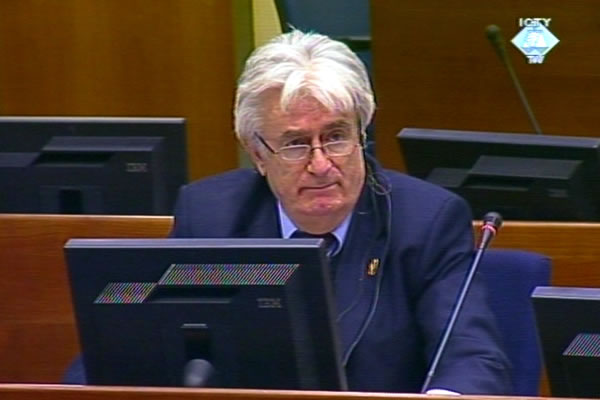Home
EVIDENCE OF POLICE INSIDER
Former Bosnian Serb police officer from Sarajevo testifies at the trial of Radovan Karadzic under protective measures. The witness spoke about the detention facilities in Lukavica and Pale and about the involvement of Branislav Gavrilovic Brne’s group, ‘Oljaca’s Chetniks’ and other paramilitary formations in the Bosnian Serb operations in the Sarajevo theatre of war
 Radovan Karadzic in the courtroom
Radovan Karadzic in the courtroom The trial of Radovan Karadzic continues with the evidence of a former Bosnian Serb police officer from Sarajevo. The witness testifies under the pseudonym KDZ 601 and with image and voice distortion to protect his identity. The witness was granted protective measures because his family had received threats after he started cooperating with the Office of the Prosecutor of the Hague Tribunal. The transcript of the witness’s interview with the investigators in 2005 was admitted into evidence.
Prosecutor Carolyn Edgerton read out the summary in court. The witness’s evidence mainly focuses on two detention facilities, Kula in Lukavica and the high school building in Pale, and the presence of paramilitary groups on the Sarajevo front. The paramilitaries included were Branislav Gavrilovic Brne’s group, the White Eagles, Arkan’s men and Oljaca’s Chetniks.
In his interview with the OTP investigators the witness said that the Kula prison was run by the police. The prisoners who had been arrested by the army, police and paramilitary groups were brought there. The witness also visited the scene of the massacre in which all the Muslims in a bus were killed near Ahatovici.
As the witness explained, he ‘heard’ from a colleague of his at a meeting in the police station in Vogosca that a member of Branislav Gavrilovic Brne’s group had opened fire at the bus. A survivor of the massacre testified at the trial of Radovan Karadzic in February 2011. According to his testimony, about 50 Bosniaks who were detained on the bus were killed when the bus was hit by rocket launchers, infantry weapons and hand grenades on 14 June 1992. Karadzic claimed that Muslim forces were responsible for the attack; as he said, ‘Serbs would never destroy their own bus’.
The village of Ahatovici was attacked in late May and early June 1992. According to the witness, ‘Oljaca’s Chetniks’ took part in the attack together with the police from the Ilidza area. The witness knew that Oljaca had come from Valjevo and was a member of the Chetnik movement. Oljaca’s group was active in the Kotorac and Ilidza area and in parts of the Serb-controlled territory near Ahatovici and Hadzici. Oljaca’s Chetniks were billeted in Muslim houses in the area between Kotorac and Vojkovici.
At the beginning of the cross-examination, Karadzic noted that the SDA in BH didn’t respect the agreement of the coalition partners on the distribution of posts in the police and other BH state bodies. The Serbian Democratic Party appointed people with appropriate qualifications to posts which were allotted to the Serbs, unlike the Democratic Action Party which appointed ‘clerics’ to various posts in the police, Karadzic contends.
Karadzic also argued that the SDA appropriated the surveillance technology and eavesdropped on Serb officials. At the same time, Karadzic continued, appropriate measures were taken against ‘the Serbs they didn’t like’, such as carving marks on the doors of their flats as a sign to the criminals indicating they could break into those properties. Things like that caused fear among the Serbs living in Sarajevo, Karadzic noted. The witness agreed saying that the V-shaped sign was carved on his door too.
Protected witness KDZ 061 will continue his evidence on Tuesday, 13 September 2011.
Linked Reports
- Case : Karadzic
- 2011-09-07 FOR WHOSE SAKE DID THE MUSLIMS FROM NOVOSEOCE DIE?
- 2011-09-06 CRIME IN THE VILLAGE OF ZAKLOPACE
- 2011-09-05 15-YEAR OLD IN LINE FOR EXECUTION
- 2011-09-13 DIVISION POLICY IN SANSKI MOST
- 2011-09-14 NO NEED TO CALL SRBAC ‘SERB SRBAC’
- 2011-09-15 DRINA RIVER AS GREATER SERBIA’S LUNGS
